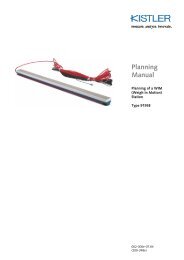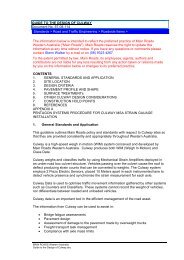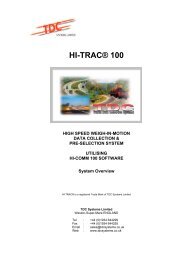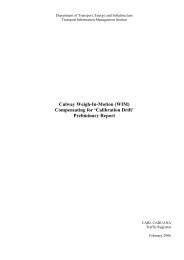AP-G84/04 Best practice in road use data collection, analysis ... - WIM
AP-G84/04 Best practice in road use data collection, analysis ... - WIM
AP-G84/04 Best practice in road use data collection, analysis ... - WIM
You also want an ePaper? Increase the reach of your titles
YUMPU automatically turns print PDFs into web optimized ePapers that Google loves.
Accessed by AR - ARRB TRANSPORT RESEARCH on <strong>04</strong> Feb 2005<br />
Put them <strong>in</strong>to b<strong>in</strong> 1 (passenger-car b<strong>in</strong>);<br />
Aust<strong>road</strong>s 20<strong>04</strong><br />
— 9 —<br />
<strong>Best</strong> Practices <strong>in</strong> Road Use Data Collection, Analysis and Report<strong>in</strong>g<br />
Distribute across the 12 b<strong>in</strong>s <strong>in</strong> proportion to the measured vehicle numbers <strong>in</strong> each b<strong>in</strong> (i.e.<br />
new b<strong>in</strong> j vehicles = old b<strong>in</strong> j vehicles × sum of b<strong>in</strong>s 1 to 13 / sum of b<strong>in</strong>s 1 to 12); and<br />
Discard them.<br />
Each of these methods has its own <strong>in</strong>adequacy. The last method <strong>in</strong> discard<strong>in</strong>g the error counts<br />
would underestimate the true traffic demand <strong>in</strong> a <strong>road</strong> network. The second method of proportional<br />
distribution across all b<strong>in</strong>s may significantly distort the true distribution if the sum of vehicles <strong>in</strong> b<strong>in</strong>s<br />
1 to 12 is small relative to the vehicles <strong>in</strong> the error b<strong>in</strong>. The first method of load<strong>in</strong>g error counts <strong>in</strong>to<br />
the passenger-car b<strong>in</strong> (b<strong>in</strong> 1) would not significantly affect the true count <strong>in</strong> b<strong>in</strong> 1 only if there are<br />
relatively large numbers of vehicles <strong>in</strong> this b<strong>in</strong>.<br />
It is thus recommended that:<br />
(a) An error b<strong>in</strong> (no. 13) be <strong>in</strong>troduced <strong>in</strong>to the Aust<strong>road</strong>s system as good <strong>practice</strong> to <strong>in</strong>dicate the<br />
quality of the classified counts;<br />
(b) The <strong>in</strong>clusion of error counts <strong>in</strong> b<strong>in</strong> 13 <strong>in</strong> the total counts requires some judgement. If the<br />
number of error counts is high relative to the total counts, it is necessary to identify the<br />
reasons for such a situation before error counts are <strong>in</strong>cluded;<br />
(c) If it is deemed appropriate to distribute b<strong>in</strong> 13 vehicles, the two distribution methods<br />
mentioned previously can be considered, or both methods are <strong>use</strong>d and guided by relevant<br />
local knowledge.<br />
(d) The number of error counts should be monitored and, if these rema<strong>in</strong> high relative to the<br />
traffic stream, the reasons for these errors should be identified and the problem rectified.<br />
3.3.3 Vehicle Classification <strong>in</strong> Urban Traffic<br />
As <strong>in</strong>dicated <strong>in</strong> Table 3, loop sensors are more suitable for collect<strong>in</strong>g vehicle classified counts on<br />
congested multi-lane highways. These sensors are usually located mid-block on arterial <strong>road</strong>s and<br />
<strong>data</strong> retrieved remotely us<strong>in</strong>g modems. Another source of classified counts is the freeway<br />
management systems now <strong>in</strong> place <strong>in</strong> capital cities. Loop sensors or virtual loops us<strong>in</strong>g imag<strong>in</strong>g<br />
technologies are <strong>in</strong>stalled at regular <strong>in</strong>tervals (e.g. 500 m) to monitor traffic flow and identify<br />
<strong>in</strong>cidents.<br />
These loop pairs calculate the spot speed and classify vehicles by length. Both 3-b<strong>in</strong> and 4-b<strong>in</strong><br />
systems have been employed <strong>in</strong> various jurisdictions. VicRoads, Ma<strong>in</strong> Roads Queensland and<br />
Transit New Zealand have reported us<strong>in</strong>g a 4-b<strong>in</strong> system. Transit New Zealand and RTA NSW<br />
also <strong>use</strong> three b<strong>in</strong>s to classify vehicles by lengths. Table 4 shows the threshold values of these<br />
systems.<br />
Vehicle class Ma<strong>in</strong> Roads<br />
Queensland<br />
Table 4 – Vehicle classification systems by lengths<br />
Vehicle lengths (m)<br />
VicRoads Transit New Zealand RTA NSW<br />
B<strong>in</strong> 1 (short) < 5.8 < 6.0 < 5.5 11.5<br />
B<strong>in</strong> 4 (comb<strong>in</strong>ation) > 21.2 > 17.5 > 17.0 -

















